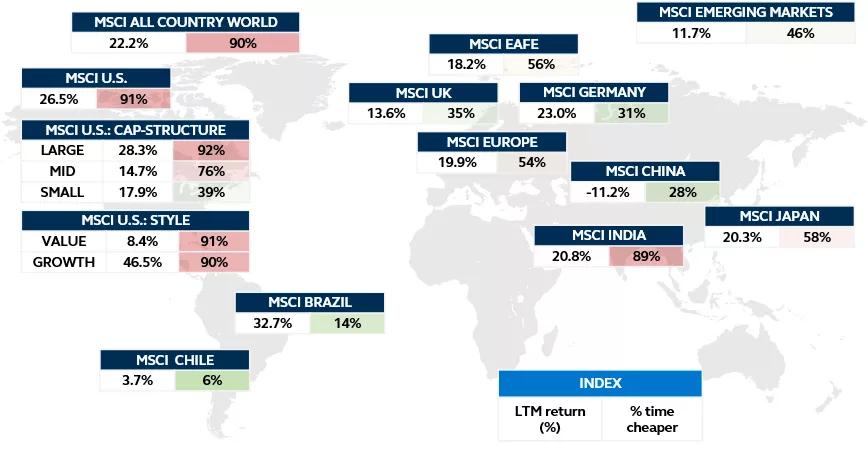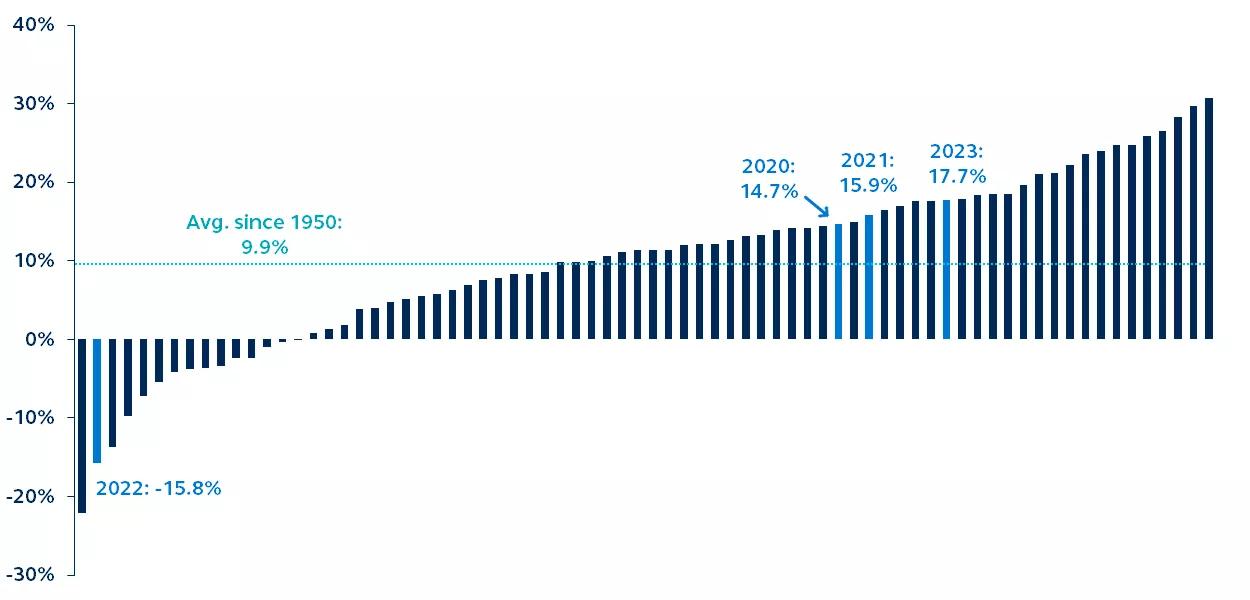At the beginning of the year, we sat down with Todd Jablonski, Global Head of Multi-Asset and Quantitative Investments, to discuss his outlook for multi-asset markets in 2024, where he sees opportunities, and potential performance drivers.

Q: What factors will drive performance across markets in 2024?
The factors we are most concerned about in 2024 will move investors in a new direction. First, we are concerned about the pace of Federal Reserve (Fed) easing in 2024. Many investors baked in expectations for easing, but it’s entirely possible the Fed could be a little late to deliver cuts. The second factor is valuations; while global equities, especially U.S. large caps, look expensive, there are plenty of valuation opportunities in mid- and small-caps and international equities. And third is earnings delivery. In an environment where growth may still be accelerating, investors are looking for reliable fundamental performance. If growth continues and we avoid a recession, we believe sales growth, profitability, and earnings will point to winners in the stock market in 2024.
Global equity returns and valuations
Last twelve months returns and % times cheaper, MSCI indices

Q: Where should investors add to their portfolios in 2024? Are there any specific asset classes or sub-asset classes that look particularly attractive?
Right off the bat, I’d recommend that investors rebalance their portfolios with a focus on freeing up capital to redeploy. One of the areas I’d send that newly freed-up capital to is equities; there are good valuation opportunities in certain pockets of the equity asset class, especially around mid- and potentially small-cap acceleration. Additionally, I’d point toward credit, where investment grade is preferred. We’ve seen some volatility around spreads in the more speculative space, so interest-rate-sensitive, higher-quality credit has the potential to add value and is an area we will be looking to add to in 2024. Finally, I would recommend some lower volatility diversifiers in asset classes without a lot of risk, such as hedge funds and short-term credit.
Q: Many investors have recently moved away from the 60/40 portfolio, but you’re a proponent of it. Why are you a fan of the 60/40 portfolio for investors in 2024?
The 60/40 portfolio is an easy target for investors to pick on and claim weakness in the construct. However, the durable nature of the 60/40 simply keeps on working. Going back a couple of years, the correlation between stocks and bonds began to rise, and many investors were worried it was the death of the 60/40 by not getting the correlation benefit. However, that correlation has come back down. For the 60% equities, investors can find good valuations and strong fundamentals in a supportive economic environment. On the 40% fixed income side, with or without a positive correlation, there is some stability in interest rate risk and owning some of the returns from spread risk. Putting those two forces together, investors should be able to achieve a certain level of diversification, so as multi-asset strategies come, the 60/40 has the potential to be efficacious in 2024.
60/40 annual returns
1950–present

Q: Some investors are looking to add another sleeve to the 60/40 approach, an alternative sleeve for example, to help add some diversification. Is that a good option heading into 2024?
I’ve seen investors take anywhere from 5%, 10%, and even up to 20% of a 60/40 portfolio and use it to achieve some sort of different implementation or diversification. In certain environments, I think that makes sense, and I can see the reasons to look at real assets, income assets, and stability assets as a complement to a 60/40 portfolio at some point in 2024. However, those alternative betas often lack the kind of return potential that you find in stocks and bonds, so I’d recommend investors consider a traditional 60/40 to start in 2024 and perhaps look at more modifiers and other diversification elements later in the investment horizon.
Q: Any final thoughts on how investors should prepare portfolios in 2024?
In 2024, discretion might be the better part of valor, meaning there’s a false choice for investors right now. The idea is that investors either need to prepare for an expansion by risking up their portfolios toward equities, high yield, and more volatile asset classes or prepare for contraction by looking to Treasurys and less volatile asset classes. Our view is that you shouldn’t fall for that binary trap. Investors can prepare their portfolios for an outcome that allows for the room to participate in the upside of positive economic events while also lowering standard deviation and protecting against risk during an uncertain investment environment.
Learn more about our asset allocation investing capabilities.
For Public Distribution in the U.S. For Institutional, Professional, Qualified and/or Wholesale Investor Use Only in other Permitted Jurisdictions as defined by local laws and regulations.
Risk Considerations
Past performance is no guarantee of future results. Investing involves risk, including possible loss of principal. Equity investments involve greater risk, including heightened volatility, than fixed income investments. Small- and mid-cap stocks may have additional risks including greater price volatility. Fixed‐ income investment options are subject to interest rate risk, and their value will decline as interest rates rise. Asset allocation and diversification or a downside risk reduction/protection strategy do not ensure a profit or protect against a loss.
Important information
This material covers general information only and does not take account of any investor’s investment objectives or financial situation and should not be construed as specific investment advice, a recommendation, or be relied on in any way as a guarantee, promise, forecast or prediction of future events regarding an investment or the markets in general. The opinions and predictions expressed are subject to change without prior notice. The information presented has been derived from sources believed to be accurate; however, we do not independently verify or guarantee its accuracy or validity. Any reference to a specific investment or security does not constitute a recommendation to buy, sell, or hold such investment or security, nor an indication that the investment manager or its affiliates has recommended a specific security for any client account.
Subject to any contrary provisions of applicable law, the investment manager and its affiliates, and their officers, directors, employees, agents, disclaim any express or implied warranty of reliability or accuracy and any responsibility arising in any way (including by reason of negligence) for errors or omissions in the information or data provided.
All figures shown in this document are in U.S. dollars unless otherwise noted. This material may contain ‘forward looking’ information that is not purely historical in nature. Such information may include, among other things, projections and forecasts. There is no guarantee that any forecasts made will come to pass. Reliance upon information in this material is at the sole discretion of the reader.
This material is not intended for distribution to or use by any person or entity in any jurisdiction or country where such distribution or use would be contrary to local law or regulation.
This document is issued in:
- The United States by Principal Global Investors, LLC, which is regulated by the U.S. Securities and Exchange Commission.
- Europe by Principal Global Investors (Ireland) Limited, 70 Sir John Rogerson’s Quay, Dublin 2, D02 R296, Ireland. Principal Global Investors (Ireland) Limited is regulated by the Central Bank of Ireland. Clients that do not directly contract with Principal Global Investors (Europe) Limited (“PGIE”) or Principal Global Investors (Ireland) Limited (“PGII”) will not benefit from the protections offered by the rules and regulations of the Financial Conduct Authority or the Central Bank of Ireland, including those enacted under MiFID II. Further, where clients do contract with PGIE or PGII, PGIE or PGII may delegate management authority to affiliates that are not authorised and regulated within Europe and in any such case, the client may not benefit from all protections offered by the rules and regulations of the Financial Conduct Authority, or the Central Bank of Ireland. In Europe, this document is directed exclusively at Professional Clients and Eligible Counterparties and should not be relied upon by Retail Clients (all as defined by the MiFID).
- United Kingdom by Principal Global Investors (Europe) Limited, Level 1, 1 Wood Street, London, EC2V 7 JB, registered in England, No. 03819986, which is authorized and regulated by the Financial Conduct Authority (“FCA”).
- United Arab Emirates by Principal Global Investors LLC, a branch registered in the Dubai International Financial Centre and authorized by the Dubai Financial Services Authority as a representative office and is delivered on an individual basis to the recipient and should not be passed on or otherwise distributed by the recipient to any other person or organisation.
- Singapore by Principal Global Investors (Singapore) Limited (ACRA Reg. No. 199603735H), which is regulated by the Monetary Authority of Singapore and is directed exclusively at institutional investors as defined by the Securities and Futures Act 2001. This advertisement or publication has not been reviewed by the Monetary Authority of Singapore.
- Australia by Principal Global Investors (Australia) Limited (ABN 45 102 488 068, AFS Licence No. 225385), which is regulated by the Australian Securities and Investments Commission and is only directed at wholesale clients as defined under Corporations Act 2001.
- This document is marketing material and is issued in Switzerland by Principal Global Investors (Switzerland) GmbH.
- Hong Kong SAR (China) by Principal Asset Management Company (Asia) Limited, which is regulated by the Securities and Futures Commission. This document has not been reviewed by the Securities and Futures Commission.
- Other APAC Countries/Jurisdictions, this material is issued for institutional investors only (or professional/sophisticated/qualified investors, as such term may apply in local jurisdictions) and is delivered on an individual basis to the recipient and should not be passed on, used by any person or entity in any jurisdiction or country where such distribution or use would be contrary to local law or regulation.
Principal Funds are distributed by Principal Funds Distributor, Inc.
© 2024 Principal Financial Services, Inc. Principal®, Principal Financial Group®, Principal Asset Management, and Principal and the logomark design are registered trademarks and service marks of Principal Financial Services, Inc., a Principal Financial Group company, in various countries around the world and may be used only with the permission of Principal Financial Services, Inc. Principal Asset Management℠ is a trade name of Principal Global Investors, LLC. Principal Asset Allocation is an investment team within Principal Global Investors.
3371920


